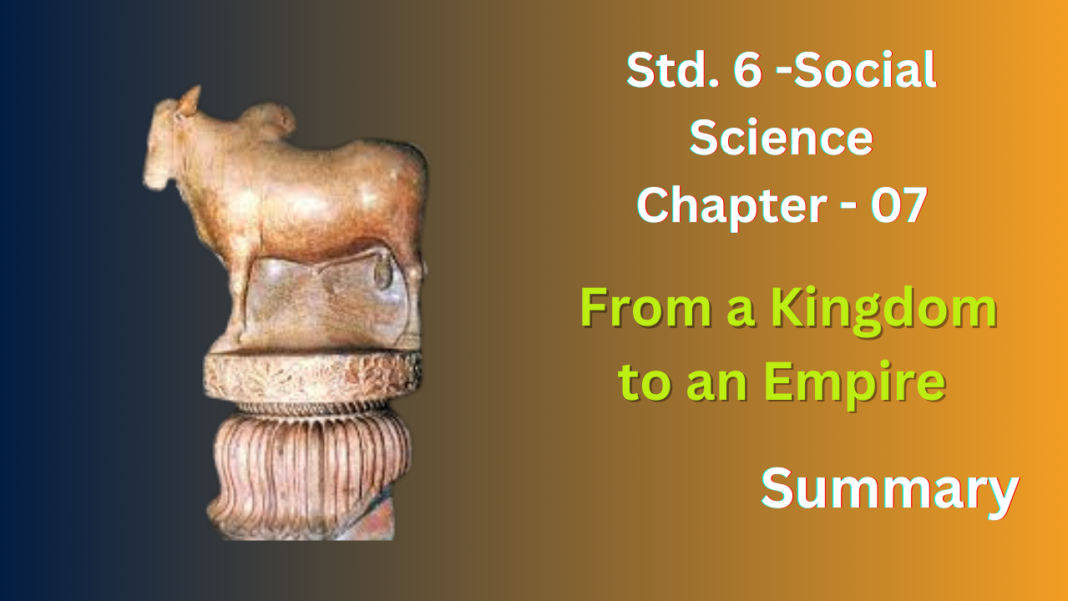NCERT Solutions for Class 6 History Chapter 7
The chapter “From a Kingdom to an Empire” likely focuses on the rise of the Mauryan Empire in ancient India. Here’s a summary of the key points:
Rise of Chandragupta Maurya:
- The chapter introduces Chandragupta Maurya, who, with the help of his advisor Chanakya, established a powerful kingdom that eventually became an empire.
- Chandragupta might have united smaller kingdoms or defeated rival rulers to expand his territory.
The Mauryan Empire:
- The Mauryan Empire is presented as a vast and powerful empire that encompassed a large part of ancient India.
- Pataliputra served as the capital city, known for its grandeur and strategic location.
Strong Administration:
- The chapter might mention the well-structured administration of the Mauryan Empire.
- Officials managed different regions, collected taxes, and maintained law and order.
- Arthashastra, a treatise on statecraft, might be briefly mentioned as a source of guidance for Mauryan administration.
Ashoka the Great:
- Ashoka, Chandragupta’s grandson, is a central figure in the chapter. He is known for embracing Buddhism and promoting peace after witnessing the horrors of war.
- Dharma (righteousness) became a key principle during Ashoka’s reign, emphasizing non-violence and moral conduct.
Spread of Buddhism:
- Ashoka played a crucial role in spreading Buddhism across India and beyond.
- He erected pillars with inscriptions containing his edicts promoting Dharma and Buddhist teachings.
- He also sent missionaries to different parts of Asia to propagate Buddhism.
Decline of the Empire:
- The chapter might briefly touch upon the decline of the Mauryan Empire after Ashoka’s reign.
- The reasons for the decline could be complex and might involve factors like weak successors, invasions, or internal conflicts.
NCERT Solutions for Class 6 History Chapter 7
Let’s recall
1. Make a list of the occupations of the people who lived within the Mauryan empire.
Ans : The Mauryan Empire encompassed a diverse population with a variety of occupations. Here’s a list of some key occupations:
- Farmers: Agriculture formed the backbone of the Mauryan economy. Farmers grew crops like rice, wheat, barley, and millets, providing the empire’s primary source of food.
- Herdsmen: Raising animals like cattle, sheep, and goats was another vital occupation. Herdsmen provided milk, meat, hides, and other animal products.
- Craftspersons: Skilled craftspersons produced a wide range of goods, including pottery, tools, textiles (woven cloth), jewelry, and metalwork. Their skills contributed significantly to the empire’s economy and artistic expression.
- Traders and Merchants: Trade flourished within the empire and extended beyond its borders. Traders and merchants transported goods like agricultural products, textiles, handicrafts, and spices, facilitating exchange and economic activity.
- Officials and Administrators: The Mauryan Empire had a well-structured administration. Officials managed different regions, collected taxes, maintained law and order, and ensured the smooth functioning of the empire.
- Soldiers: A strong military was crucial for maintaining the vast empire. Soldiers protected the borders, quelled rebellions, and played a role in territorial expansion during Chandragupta Maurya’s reign.
- Other Occupations: There were likely other occupations like entertainers, artists, scholars, religious figures, and laborers who contributed to the social and cultural fabric of the Mauryan Empire.
2. Complete the following sentences:
(a) Officials collected_____from the area under the direct control of the ruler.
(b) Royal princes often went to the provinces as_____.
(c) The Mauryan rulers tried to control____and____which were important for transport.
(d) People in forested regions provided the Mauryan officials with_____.
Ans : (a) Taxes
(b)Governors (or viceroys).
(c) Rivers and roads
(d) Forest products like timber, ivory, or medicinal herbs.
3. State whether true or false:
(a) Ujjain was the gateway to the north-west.
(b) Chandragupta’s ideas were written down in the Arthashastra.
(c) Kalinga was the ancient name of Bengal.
(d) Most Ashokan inscriptions are in the Brahmi script.
Ans : (a) False
(b) False
(c) False
(d) True
Let’s discuss
4. What were the problems that Ashoka wanted to solve by introducing dhamma?
Ans : Ashoka, after witnessing the horrors of the Kalinga War, embraced Buddhism and strived to create a more peaceful and just society. He introduced Dharma, a set of principles based on Buddhist teachings, to address several problems within the Mauryan Empire:
- Violence and Warfare: The primary aim was to reduce violence and warfare. Ashoka deeply regretted the bloodshed of the Kalinga War and sought to promote peace and non-violence (ahimsa).
- Social Inequality: Dharma might have aimed to bridge social inequalities by emphasizing compassion, respect for all living beings, and the importance of fulfilling one’s duties within society.
- Moral Decline: The concept of Dharma might have been a response to a perceived moral decline within the empire. It promoted ethical conduct, truthfulness, and non-cruelty.
- Religious Tensions: With a diverse population and different religious beliefs, Dharma might have aimed to create a more tolerant and harmonious society.
5. What were the means adopted by Ashoka to spread the message of dhamma?
Ans : Ashoka, determined to spread the message of Dharma throughout his vast empire, adopted a multi-pronged approach:
1. Dhamma Mahamatras:
- He appointed officials called Dhamma Mahamatras. These officials traveled throughout the empire, educating people about the principles of Dharma, promoting ethical conduct, and ensuring fair treatment for all.
2. Rock and Pillar Edicts:
- Ashoka commissioned the carving of numerous rock and pillar edicts. These inscriptions, written in various languages like Brahmi and Kharoshthi, spread his message across diverse regions. They highlighted the importance of Dharma, non-violence, respect for elders, and following a righteous path.
3. Sending Missions:
- Ashoka is known for sending out missions beyond the borders of his empire to propagate Buddhist teachings. These missions, particularly to Sri Lanka and Southeast Asia, played a crucial role in the international spread of Buddhism.
4. Leading by Example:
- Ashoka himself set a strong moral example. He renounced violence, embraced a simple life, and promoted pilgrimage to holy Buddhist sites. This personal commitment to Dharma helped legitimize his message among his subjects.
5. Public Welfare Measures:
- Ashoka’s emphasis on Dharma extended to public welfare measures. He built hospitals for people and animals, encouraged planting trees for shade, and constructed wells to ensure access to water. These actions reflected his concern for the well-being of all living beings.
6. Why do you think slaves and servants were ill-treated? Do you think the orders of the emperor would have improved their condition? Give reasons for your answer.
Ans : Slaves and servants faced harsh treatment due to their low social status, economic value as property, and lack of legal protection. An emperor’s orders might have had limited impact due to difficulty in enforcement, ingrained social norms, and focus on specific issues. While they could set a moral tone or create legal frameworks, significant reforms were needed for lasting change.
FAQ’s
What topics are covered in Class 6 History Chapter 7: “From a Kingdom to an Empire”?
Class 6 History Chapter 7 explores the transition of ancient civilizations from kingdomhood to imperial power, covering topics such as the expansion of territories, administrative systems, and the consolidation of power.
How can NCERT solutions for Class 6 History Chapter 7 aid in understanding the transition from a kingdom to an empire?
NCERT solutions offer detailed explanations and analyses of historical events and concepts related to the transition from kingdoms to empires, helping students grasp the complexities of political transformations and power dynamics in ancient civilizations.
Where can I find NCERT solutions for Class 6 History Chapter 7?
NCERT solutions for Class 6 History Chapter 7 can be found online or in study materials provided by educational platforms or institutes specializing in academic resources.
When should I refer to NCERT solutions for Class 6 History Chapter 7?
NCERT solutions are beneficial for reinforcing learning, clarifying doubts, and preparing for exams. They can be used alongside regular study or as a revision tool before assessments to enhance understanding of the transition from kingdoms to empires in ancient civilizations.
What specific historical examples are discussed in Class 6 History Chapter 7 regarding the transition from a kingdom to an empire?
Class 6 History Chapter 7 discusses various historical examples of civilizations transitioning from kingdoms to empires, such as the Mauryan Empire in ancient India and the Roman Empire, offering insights into the factors and processes involved in this transformative journey.









